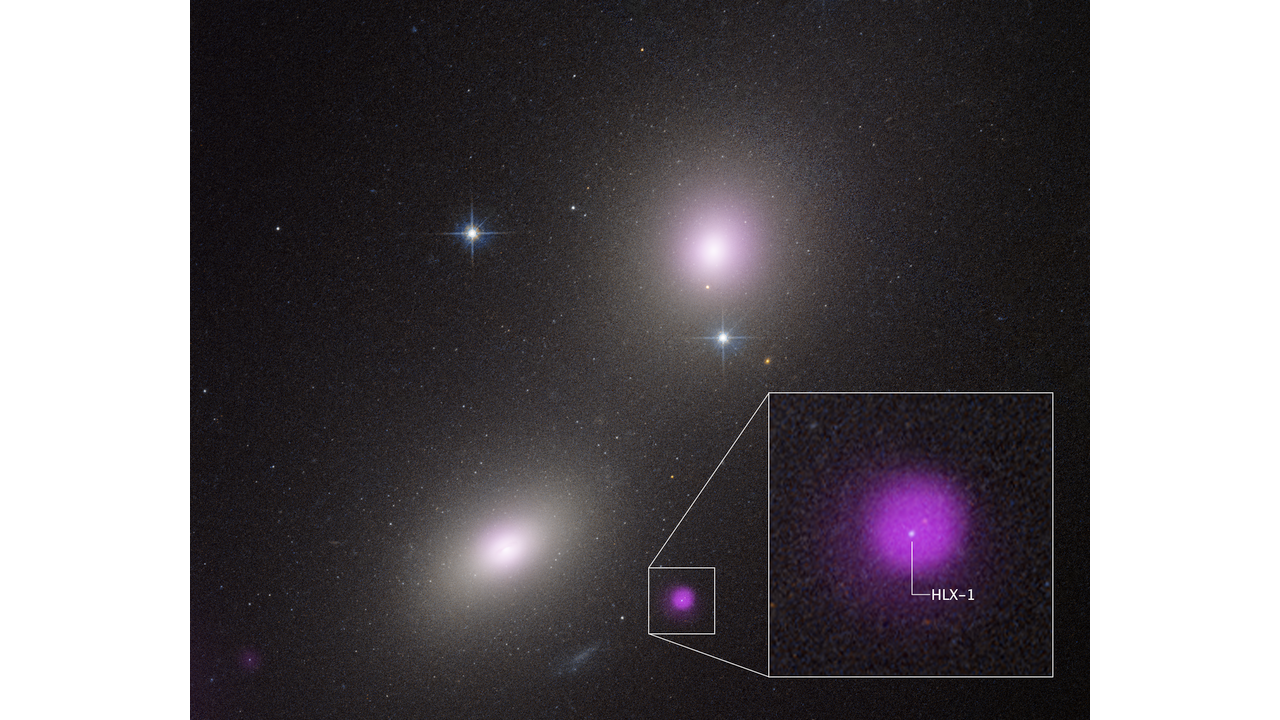Roberto Soria – Osservatorio Astrofisico di Torino
| A transient X-ray source seen in the halo of an elliptical galaxy could be a rare example of a black hole bigger than those formed from massive stars but smaller than typical supermassive black holes found in the nuclei of most galaxies. The discovery has been published on the Astrophysical Journal (Yi-Chi Chang et al. 2025, “Multiwavelength Study of a Hyperluminous X-Ray Source near NGC 6099: A Strong IMBH Candidate”)by a team that includes also Roberto Soria, an INAF-OATo astronomer. |  |
| The elusive objects investigated in this study are known as intermediate mass black holes (IMBHs), with masses between a few 100 and a few 100 thousand times the mass of the Sun. Theory predicts the existence of IMBHs in the core of dense star clusters and in the nuclei of dwarf galaxies, where they did not have enough fuel to grow to supermassive size. However, very few IMBHs have been directly observed.
The elliptical galaxy that appears to host an X-ray bright IMBH is NGC 6099, located 450 million light years from us, in the Hercules constellation. The X-ray source is at least 40,000 light years away from the galactic nucleus. It first caught the astronomers’ attention in 2009 when it was detected by NASA’s Chandra X-ray Observatory: it appeared already unusually bright for a stellar-mass black hole. Follow-up observations in 2012 with ESA’s XMM-Newton X-ray Observatory showed that it had become 100 times more luminous than in 2009. New X-ray observations from 2023, also with XMM-Newton, showed a decline to the 2009 level. The extreme X-ray luminosity (for a non-nuclear black hole) and the characteristic temperature of the radiation are consistent with an IMBH. But how did it end up in the outskirts of that galaxy? One scenario is that the IMBH was initially formed in the nucleus of a small satellite galaxy near NGC 6099. When the satellite galaxy sank and dissolved into the halo of the larger companion (as is often the case for dwarf satellites), its nuclear IMBH remained floating in the outskirts of NGC 6099, still surrounded by a tightly bound cluster of stars. If this scenario is correct, IMBHs in the halo of large galaxies are a fossil record of the growth of that galaxy via accretion of smaller companions. Why did the IMBH become so luminous in recent years? High X-ray luminosity is a signal that a black hole is swallowing a large amount of material. There is very little gas in those remote outskirts of NGC 6099. However, if the IMBH is inside a dense cluster of stars, one of those stars may have passed too close to the black hole, and may have been shredded and ingested, powering the X-ray emission. Astronomers call this process a tidal disruption event. The team of researchers conducted follow-up observations in the optical bands with the Hubble Space Telescope, They found a bright, compact optical source at the location of the X-ray source. This is consistent with the presence of a cluster of stars around the IMBH. For future studies, finding more IMBHs suddenly lighting up in the halo of large galaxies will tell us how many of those (usually invisible) black holes there are in the nearby Universe, how often they disrupt a star, and how bigger galaxies have grown by assembling smaller galaxies. The challenge is that Chandra and XMM-Newton only look at a small fraction of the sky, so they have very small chances to find tidal disruption events that occur at random locations in the sky. Instead, the Einstein Probe X-ray Telescope (a Chinese mission launched in 2024) has a larger field of view and a better chance to find random X-ray transients. In the optical bands, the Legacy Survey of Space and Time (LSST), from the Rubin Observatory in Chile, will detect such events as far as hundreds of millions of light years away. Both Einstein Probe and LSST have INAF-OATo researchers in their science teams. Follow-up observations with the Hubble and James Webb space telescopes can then reveal the existence and properties of star clusters around those IMBHs. |
|

Immagine Hubble della coppia di galassie NGC 6099 (in basso a sinistra) e NGC 6098 (in alto a destra). L'oggetto viola vicino a NGC 6099 e' la luminosa sorgente X scoperta dalle osservazioni Chandra e XMM-Newton. I fotoni X sono probabilmente prodotti da un intermediate mass black hole che ha distrutto e sta ingoiando una stella passata troppo vicina.
